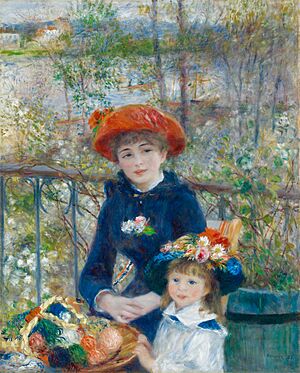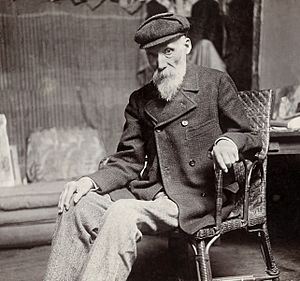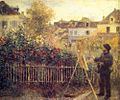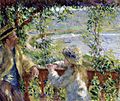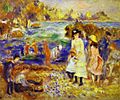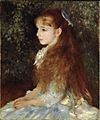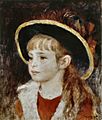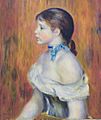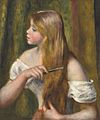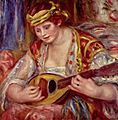Pierre-Auguste Renoir facts for kids
Quick facts for kids
Pierre-Auguste Renoir
|
|
|---|---|
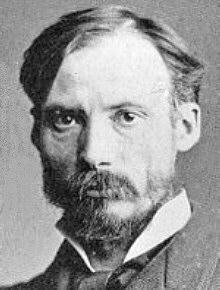 |
|
| Nationality | French |
| Known for | Painting |
| Movement | Impressionism |
Pierre-Auguste Renoir (born February 25, 1841 – died December 3, 1919) was a famous French artist. He was a very important painter who helped start the Impressionist art style. He loved to paint portraits of people, everyday objects (called still life), and especially scenes of people's lives and gatherings.
People often say that Renoir was one of the last great painters in a long line of artists, like Rubens and Watteau, who were famous for painting women.
Contents
Renoir's Early Life
Pierre-Auguste Renoir was born in Limoges, France. His family was not rich. As a young boy, he worked in a porcelain factory. His talent for drawing meant he was chosen to paint designs on fancy china.
He also painted decorations on fans and hangings for missionaries before he went to art school. During these early years, he often visited the Louvre museum in Paris. There, he studied the works of famous French master painters.
Becoming a Master Painter
In the late 1860s, Renoir and his friend Claude Monet made an important discovery. They painted outdoors, which is called en plein air in French. They learned that the color of shadows isn't just brown or black. Instead, shadows show the colors reflected from objects around them. This effect is known as diffuse reflection.
Renoir and Monet sometimes painted the same scenes side-by-side. For example, they both painted La Grenouillère in 1869.
Renoir first became well-known when six of his paintings were shown at the first Impressionist exhibition in 1874. That same year, two of his artworks were displayed in London.
One of his most famous Impressionist paintings is Bal du moulin de la Galette from 1876. This painting shows a lively outdoor scene with many people dancing. It takes place at a popular dance garden in Montmartre, Paris, near where he lived. His early paintings were like colorful snapshots of real life, full of bright light.
A Change in Style
In 1881, Renoir traveled to Italy. He saw amazing artworks by Raphael and other Renaissance masters. This trip made him feel like he needed to change his painting style. For several years after this, he painted in a more serious, classical way.
However, after 1890, he changed his mind again. He went back to using thin layers of paint and softer outlines, like his earlier work. From then on, he focused on painting nudes and everyday domestic scenes.
Renoir was a very productive artist, creating thousands of paintings. His warm and beautiful style made his paintings some of the most famous and copied artworks ever. The largest collection of his works, 181 paintings, is at the Barnes Foundation in Philadelphia.
Renoir's Family Life
In 1890, Renoir married Aline Victorine Charigot. She had been a model for one of his famous paintings, Le Déjeuner des canotiers (Luncheon of the Boating Party, 1881). They already had a son named Pierre, born in 1885.
After they married, Renoir painted many scenes of his wife and their family life. This included their children and Aline's cousin, who was their nurse. The Renoirs had three sons. One son, Jean, became a famous film director. Another son, Pierre, became a stage and film actor.
Later Years and Legacy
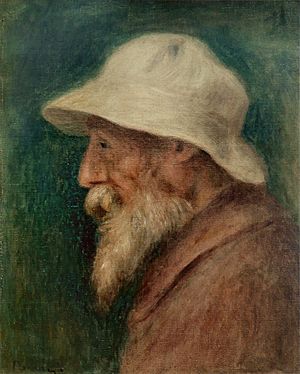
Around 1892, Renoir developed rheumatoid arthritis, a condition that affects the joints. In 1907, he moved to a warmer place called "Les Collettes," a farm near Cagnes-sur-Mer, by the Mediterranean coast.
Renoir continued to paint for the last twenty years of his life, even when his arthritis made it very hard to move. He was in a wheelchair and his hands became deformed. He even had to change how he painted. It's often said that he had a brush strapped to his hand, but he could still hold a brush. He just needed help placing it in his hand. The bandages on his hands, seen in later photos, helped protect his skin.
During this time, he also created sculptures. He worked with a young artist named Richard Guino, who helped him shape the clay. Renoir also used a special moving canvas to help him paint large artworks.
In 1919, Renoir visited the Louvre museum to see his own paintings hanging next to those of the old masters. He passed away in the village of Cagnes-sur-Mer on December 3rd of that year.
Renoir's Art Style

Renoir's paintings are known for their bright light and rich, vibrant colors.
His first paintings showed the influence of other artists. He was inspired by the colors of Eugène Delacroix and the bright light in Camille Corot's work. He also liked the realistic style of Gustave Courbet and Édouard Manet, and used black in his early works like they did. Renoir also admired Edgar Degas's way of showing movement. Other painters Renoir greatly admired were the 18th-century masters François Boucher and Jean-Honoré Fragonard.
Renoir's unique style made his paintings some of the most famous and often copied artworks in history. The largest collection of his works, with 181 paintings, is at the Barnes Foundation in Philadelphia.
Gallery
-
Bal au moulin de la Galette (Montmatre) 1876
-
The Theater Box, 1874, Courtauld Institute Galleries, London
-
The Swing (La Balançoire), 1876, oil on canvas, Musée d'Orsay, Paris
-
Girls at the Piano, 1892, Musée d'Orsay, Paris
-
Portrait of Alphonsine Fournaise, 1879, Musée d'Orsay, Paris, France
-
Portrait of Alfred Sisley, 1868
-
Claude Monet Painting in His Garden at Argenteuil, 1873, Wadsworth Atheneum, Hartford, Connecticut
-
Portrait of Claude Monet, 1875, Musée d'Orsay, Paris, France
-
A Girl with a Watering Can, 1876, National Gallery of Art, Washington, D.C.
-
Mme. Charpentier and her children, 1878, Metropolitan Museum of Art, New York
-
Portrait of Alphonsine Fournaise, 1879, Musée d'Orsay, Paris, France]]
-
By the Water, 1880, Art Institute of Chicago, Chicago, Illinois
-
Luncheon of the Boating Party, 1880–1881, The Phillips Collection, Washington, D.C.
-
Portrait of Charles and Georges Durand-Ruel, 1882
-
Dance at Bougival, 1882–1883, (woman at left is painter Suzanne Valadon), Boston Museum of Fine Arts
-
Dance in the Country (Aline Charigot and Paul Lhote), 1883, Musée d'Orsay, Paris
-
Pencil study for Dance in the Country, 1883, Honolulu Museum of Art
-
Children at the Beach at Guernsey, 1883, Barnes Foundation, Philadelphia
-
Girl With a Hoop, 1885, National Gallery of Art, Washington, D.C.
-
Still Life: Flowers, 1885, Solomon R. Guggenheim Museum, New York
-
Julie Manet with cat, 1887
-
Portrait of Berthe Morisot and daughter Julie Manet, 1894
-
Gabrielle Renard and infant son Jean Renoir, 1895
-
Portrait of Ambroise Vollard, 1908
-
Portrait of Paul Durand-Ruel, 1910
-
Portrait of Ambroise Vollard, 1917
-
Self-portrait, 1875
-
Self-portrait, 1876
-
Self-portrait, 1910
Images for kids
-
Two Sisters (On the Terrace), oil on canvas, 1881, Art Institute of Chicago
-
La Parisienne, 1874, (Henriette Henriot), National Museum Cardiff
-
Mother and Children, 1876, Frick Collection, New York City
-
Portrait of Jeanne Samary, 1877, Pushkin Museum, Moscow
-
Sleeping Girl with a Cat, Clark Art Institute, Williamstown, Massachusetts
-
Pink and Blue showing Alice and Elisabeth Cahen d'Anvers, 1881, São Paulo Museum of Art, São Paulo
-
Dance at Bougival, 1882–1883, (woman at left is painter Suzanne Valadon), Boston Museum of Fine Arts
-
Dance in the City, 1883, Musée d'Orsay, Paris, France
-
Children at the Beach at Guernsey, 1883, Barnes Foundation, Philadelphia
-
La Roche Guyon, 1885–86, Aberdeen Art Gallery
-
Portrait of Berthe Morisot and daughter Julie Manet, 1894
-
Head of a Young Woman, late 19th century (Minneapolis Institute of Art)
-
Woman with a Mandolin, 1919
See also
 In Spanish: Pierre-Auguste Renoir para niños
In Spanish: Pierre-Auguste Renoir para niños



